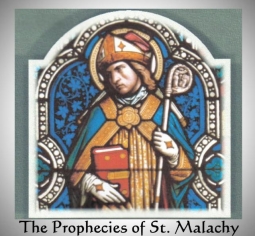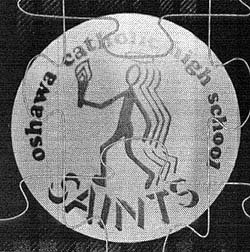Some recent posts on religion on soundingsjohnbarker. Most have a decidedly Catholic flavour, but definitely not all, as my writing on religion can be as eclectic and wide-ranging into other areas of the Christian realm as my writing on non-religious topics can be. So, if you’re a Catholic, buckle in for some discussion of eschatology in the form of Bible prophecy, premillennial dispensationalism, Petrus Romanus, the Prophecy of Malachy or Prophecy of the Popes, the Antichrist, the False Prophet and The Rapture, and if you’re a Protestant evangelical … well, welcome to my world, which includes St. Denis, patron saint of Paris, and one of the Catholic Church’s most famous cephalophore (a.k.a. head-carrier) saints.
Retroactively spiked: The post-publication killing of Msgr. Charles Pope’s blog post on New York City’s St. Patrick’s Day Parade
In the old days, publishers and newspaper owners would from time to time “kill” a writer’s column before publication. Despite their ballyhoo and blather about freedom of the press, publishers and newspaper proprietors are almost universally in my long experience with them a timid lot, if not outright moral cowards at times, always afraid of offending someone. Freedom of the press is the last thing they want when it comes to staff.
EWTN: The late 19th century English Catholic poet Francis Thompson and The Hound of Heaven
Eternal Word Television Network (EWTN) routinely offers intelligent television viewing, employing the best in Catholic faith and reason. But sometimes it offers something truly extraordinary such as its Oct. 16 special telling the story of the late and now largely forgotten 19th century English Catholic poet Francis Thompson and his famous 1893 poem, “The Hound of Heaven,” published in his first volume of poems.
St. Augustine and Jean-Jacques Rousseau: Saints vs. Scoundrels – EWTN’s TV for the Thinking Catholic (and atheists, too)
Whoever said television can’t tackle big ideas apparently forgot to tell that to Benjamin Wiker. Tomorrow Eternal Word Television Network (EWTN), the network which presents around-the-clock Catholic-themed programming, founded by Mother Mary Angelica, which began broadcasting on Aug. 15, 1981 from a garage studio at the Our Lady of the Angels Monastery in Irondale, Alabama, which Mother Angelica founded in 1962, will air in several different time slots Part 1 of its series Saints vs. Scoundrels, hosted by Wiker, a senior fellow at the Veritas Center for Ethics and Public Life at Franciscan University in Steubenville, Ohio. Wiker guides viewers through pairs of influential Catholic saints and thinkers and those the church considers important historical figures, but scoundrels and sinners nonetheless.
The Prophecy of Malachy
While most people looked at U.S. President Barack Obama’s first meeting with Pope Francis at the Vatican March 27 as a brief getting-to-know you session at the Vatican between two charismatic world leaders, who while they both champion economic social justice, are deeply divided philosophically on other moral issues such as abortion, contraception and same-sex marriage, others see them working in concert ushering in an eschatological end times.
https://soundingsjohnbarker.wordpress.com/2014/09/04/the-prophecy-of-malachy/
Blood Moon rising
Science and religion. In astronomical terms, on April 15 there was a total lunar eclipse. It was the 56th eclipse of the Saros 122 series. But in religious terms, it was known as the first Blood Moon of the 21st century.
https://soundingsjohnbarker.wordpress.com/2014/09/04/blood-moon-rising/
News and religion: Where the twain meets
“Is this the Gate of Hell? Archaeologists say temple doorway belching noxious gas matches ancient accounts of ‘portal to the underworld.’” For a minute, I thought I must be reading a headline on April 4, 2013 (after checking to make sure it wasn’t April 1) from what had to be the second coming of the late Generoso Pope, Jr.’s Weekly World News, a supermarket “news” tabloid published out of Lantana and later Boca Raton, Florida from 1979 to 2007.
https://soundingsjohnbarker.wordpress.com/2014/09/12/news-and-religion-where-the-twain-meets/
Spiritual warfare
Spiritual warfare?
In The Lion, The Witch, And The Wardrobe, the novel for children published in October 1950, C.S. Lewis, one of the leading Christian apologists of the 20th century wrote, “There is no neutral ground in the universe. Every square inch, every split second, is claimed by God and counterclaimed by Satan.”
Spiritual warfare was what Lewis was talking about almost six and a half decades ago, just as the Epistle of Saint Paul to the Ephesians almost 2,000 years earlier had said, “For we wrestle not against flesh and blood, but against principalities, against powers, against the rulers of the darkness of this world, against spiritual wickedness in high places.”
https://soundingsjohnbarker.wordpress.com/2014/09/04/spiritual-warfare/
We’re caught in a trap: Suspicious minds
Way back when, 20 or more years ago, when I decided religion was a subject journalists should take seriously if they wanted to understand the world around them and what animates many people, I happened to read a book called Faith, Hope, No Charity: An Inside Look At the Born Again Movement in Canada and the United States, published 30 years ago in 1984 by Judith Haiven, now an associate professor in the Department of Management at Saint Mary’s University in Halifax.
https://soundingsjohnbarker.wordpress.com/2014/09/10/were-caught-in-a-trap-suspicious-minds/
Today marks the Oct. 9 Feast of St. Denis, patron saint of Paris, and one of the Catholic Church’s most famous cephalophore (a.k.a. head-carrier) saints
St. Denis, one of the Fourteen Holy Helpers, who sometime after 250AD was martyred but not before, according to the Golden Legend, miraculously is said to have picked up his severed head and preached a sermon with it in his hands while walking seven miles from Montmartre where he had been beheaded.
The Catholic Church, of course, when it investigated the story of St. Denis wanted to make sure the distance he walked with his head in his hands was correctly asserted as about seven miles. There was some suggestion it was only six miles. Now, that’s a true Catholic debate. Also honored along with Saint Denis today are his two companions, a priest named Rusticus, and a deacon, Eleutherius, who were martyred alongside him and buried with him.
John McCandlish Phillips
John McCandlish Phillips, who died last year at the age of 85, lived in relative obscurity in New York City, where he was affiliated with the Manhattan-based New Testament Missionary Fellowship, a small evangelical Pentecostal congregation of perhaps three-dozen members; it is a church he helped co-found in 1962.
From time to time, as part of their evangelization effort, Phillips could be heard proselytizing for Christianity in Central Park or the Columbia University campus, near his home. Phillips also spent part of his time managing Thomas E. Lowe, Ltd., a small religious publishing house that buys remaindered religious books and reprints a few others, selling them to Christian bookstores.
John McCandlish Phillips, with his plain-sounding declarative writing voice, also happens to have been perhaps the single best writer who ever tapped the typewriter keys as a reporter at the New York Times. That is until he retired after 21 years at the age of 46 in December 1973. He had joined the paper as a night copy boy in 1952.
Just how good was McCandlish Phillips, the byline he would eventually write under after first writing as John M. Phillips, although colleagues knew him as John in the newsroom, as a reporter and writer? According to Timesmen, he was without peer. Fellow New York Times writer and noted author Gay Talese described Phillips as the “Ted Williams of the young reporters” after the legendary baseball slugger. “He was a natural. There was only one guy I thought I was not the equal of, and that was McCandlish Phillips.” His stories often focused on forgotten people and he was best known as a feature writer with a flair for style.
Shemitah: The next sabbath year begins Sept. 25
Most of us are familiar with the concept of sabbaticals every seven years for tenured professors in academia, where their university employers release them from regular teaching and research duties to re-charge their intellectual batteries and perhaps pursue some specialized interest or write a book in some suitably warm climate. What more convivial or better place to write a monograph on your latest polar research than some island in the Caribbean after all is said an done?
The roots of such sabbaticals or shemitahs, also spelled as shmitas, however, long pre-date the modern or even medieval university. Their ancient roots are 3,000 years old and are grounded in the seventh year of the seven-year agricultural cycle mandated by the Torah for the Land of Israel and still observed in contemporary Judiasm. During a shemita year, the land is left to lie fallow. Israel has alloted $28.8 million to farmers for the upcoming shemitah year, budgeting $863,000 less than the last shemitah, when lands were left fallow seven years ago. More recently, some Wall Street analysts have pondered the mystery of what appears to be seven-year economic cycles tied to shemitah years. And wondered why crashes often seem to come in September and October.
The next shemitah year – and the first since the demise of Lehman Brothers investment bank on Sept. 15, 2008, triggering the financial meltdown that resulted in the Great Recession, the most financially cataclysmic event since the decade of the Great Depression from 1929 to 1939 – begins in less than three weeks on Sept. 25, running until Sept. 13, 2015. Before declaring bankruptcy in 2008, Lehman Brothers, founded by Henry and Emanuel Lehman in 1850 in Montgomery, Alabama, was the fourth-largest investment bank in the Unites States, behind Goldman Sachs, Morgan Stanley and Merrill Lynch, doing business in investment banking, equity and fixed-income sales and trading, especially in U.S. Treasury securities, research, investment management, private equity, and private banking.
https://soundingsjohnbarker.wordpress.com/2014/09/05/shemitah-the-next-sabbath-year-begins-sept-25/
High school redux
Being a Catholic high school graduate wasn’t high on the list of things top of mind when I moved to Manitoba in 2007. That’s mainly because my high school days were some 30 years behind me – or at least so I thought at the time.
Turns out, however, Sister Andrea Dumont, the longest-serving religious in Thompson, is originally from St. Catharines, Ontario and a member of the Congregation of the Sisters of St. Joseph of Toronto, who – wait for it – just happen to be the same sisters who taught some of my classes from September 1971 to June 1976 when Sister Conrad Lauber was principal and Sister Dorothy Schweitzer taught me several English classes – and Grade 10 general math at Oshawa Catholic High School (previously known as St. Joseph’s High School and later Monsignor Paul Dwyer Catholic High School.) Sister Dorothy also taught high school in Toronto, Vancouver and Edmonton, as well as Oshawa.
Trying to teach me high school math must have given real meaning to terms like “long suffering” and “patience of a saint.” As I recall, there were two mathematics “streams” back then: “advanced” and “general.” Since these were in the days before there was much articulation of the concept of “bullying,” many of your classmates had no reservation about saying that “general” math was for “dummies” or “dunces.” Self-esteem aside, I’d have been hard-pressed to argue the point, especially since I struggled with math no matter what the label: algebra, geometry, functions and relations – shoot me now, just remembering the words, much less the symbols and equations. If I had known how many percentages I would have to convert as a journalist, I might have paid more attention to high school math, but perhaps not.
https://soundingsjohnbarker.wordpress.com/2014/09/20/high-school-redux/
Flying largely under the mainstream cinematic radar: Christian movie genre is ‘hot’
The 10-day Toronto Film Festival (TIFF) from Sept. 4 through Sept. 14 just wrapped up yesterday. In the cinema world, TIFF is a big deal. An important arts event eagerly anticipated every September.
But flying largely under the mainstream cinematic radar there is a whole slew of movies released over the last year or just about to be released, which might surprise you both in their totality and who stars in them because Hollywood, for a season at least, has rediscovered the Christian movie genre and the religious, spiritual and supernatural themes that are woven into their fabric. In a word, Christian movies are “hot” in 2014. Hollywood, which is usually a synonym for Sodom or Gomorrah in the vocabulary for many Christians, is this fall on the side of the angels. There is apparently an upside for Hollywood where commercial potential stands in for faith in salvation if need be.
You can also follow me on Twitter at: https://twitter.com/jwbarker22














